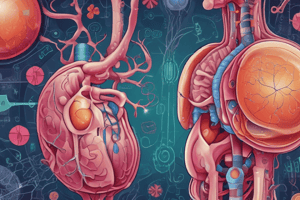Podcast
Questions and Answers
What is the key step in the evaluation of abdominal complaints such as pain, distension, enlarged organs, or masses?
What is the key step in the evaluation of abdominal complaints such as pain, distension, enlarged organs, or masses?
- Ordering laboratory and imaging studies
- Assessing the thoracic diaphragm
- Palpating the abdomen
- Correlating the information obtained in the medical interview with the physical examination findings (correct)
Where does the abdominopelvic cavity lie?
Where does the abdominopelvic cavity lie?
- Below the thoracic diaphragm
- Between the thoracic diaphragm and the pelvic diaphragm (correct)
- Above the pelvic diaphragm
- Between the ribs and the pelvic diaphragm
What do the two continuous cavities in the abdominopelvic cavity contain?
What do the two continuous cavities in the abdominopelvic cavity contain?
- The abdominal cavity and the thoracic cavity
- The pelvic cavity and the retroperitoneum
- The abdominal cavity and the pelvic cavity (correct)
- The retroperitoneum and the abdominal cavity
How is the abdomen traditionally divided for descriptive purposes?
How is the abdomen traditionally divided for descriptive purposes?
Where are the kidneys located in relation to the peritoneum?
Where are the kidneys located in relation to the peritoneum?
What is the goal of correlating information obtained in the medical interview with the findings during abdominal examination?
What is the goal of correlating information obtained in the medical interview with the findings during abdominal examination?
Which method is recommended for palpating the left kidney?
Which method is recommended for palpating the left kidney?
When are the kidneys usually palpable?
When are the kidneys usually palpable?
How is the width of the aorta assessed?
How is the width of the aorta assessed?
What is the typical location for feeling aortic pulsations?
What is the typical location for feeling aortic pulsations?
How is spleen palpation typically performed?
How is spleen palpation typically performed?
What action should be taken while assessing kidney palpation?
What action should be taken while assessing kidney palpation?
In which position might enlarged kidneys be more palpable?
In which position might enlarged kidneys be more palpable?
What might affect detection of aortic pulsations?
What might affect detection of aortic pulsations?
"The kidneys are retroperitoneal and usually not palpable". When might they be palpable?
"The kidneys are retroperitoneal and usually not palpable". When might they be palpable?
What should be used to feel deep in the right upper quadrant (RUQ)?
What should be used to feel deep in the right upper quadrant (RUQ)?
What is the main purpose of auscultation in the abdominal examination?
What is the main purpose of auscultation in the abdominal examination?
When performing percussion during abdominal examination, what does dullness on the left side suggest?
When performing percussion during abdominal examination, what does dullness on the left side suggest?
How can liver size and shape be estimated during abdominal examination?
How can liver size and shape be estimated during abdominal examination?
What is the purpose of spleen percussion during abdominal examination?
What is the purpose of spleen percussion during abdominal examination?
What is the primary reason for using deep palpation in abdominal examination?
What is the primary reason for using deep palpation in abdominal examination?
During abdominal examination, what does tympany usually indicate when performing percussion?
During abdominal examination, what does tympany usually indicate when performing percussion?
What does auscultation for at least 2 minutes aim to detect during abdominal examination?
What does auscultation for at least 2 minutes aim to detect during abdominal examination?
What is the hook technique used for during liver palpation in abdominal examination?
What is the hook technique used for during liver palpation in abdominal examination?
What should be done before performing percussion or palpation during abdominal examination?
What should be done before performing percussion or palpation during abdominal examination?
Light Palpation during abdominal examination is primarily used for detecting:
Light Palpation during abdominal examination is primarily used for detecting:
Flashcards are hidden until you start studying




